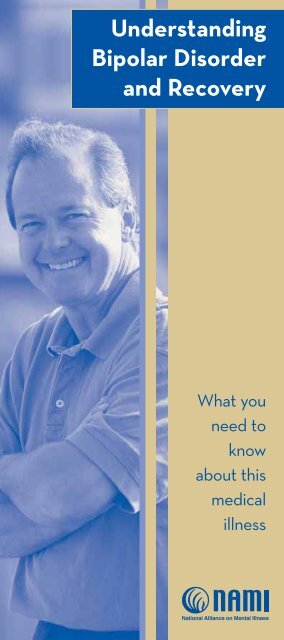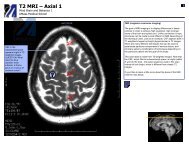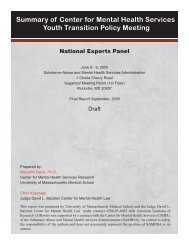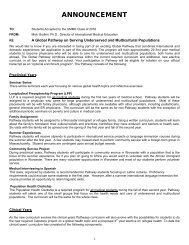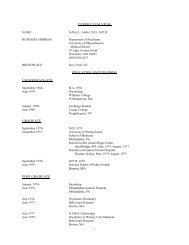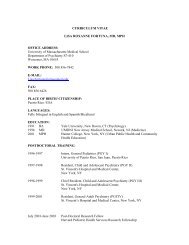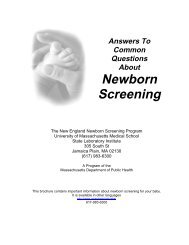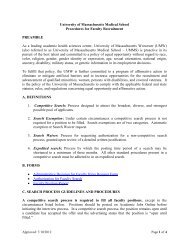Understanding Bipolar Disorder and Recovery (PDF) - NAMI
Understanding Bipolar Disorder and Recovery (PDF) - NAMI
Understanding Bipolar Disorder and Recovery (PDF) - NAMI
Create successful ePaper yourself
Turn your PDF publications into a flip-book with our unique Google optimized e-Paper software.
<strong>Underst<strong>and</strong>ing</strong><br />
<strong>Bipolar</strong> <strong>Disorder</strong><br />
<strong>and</strong> <strong>Recovery</strong><br />
What you<br />
need to<br />
know<br />
about this<br />
medical<br />
illness
<strong>Bipolar</strong> disorder<br />
expresses itself<br />
in an irregular<br />
pattern of changes<br />
in mood, energy,<br />
<strong>and</strong> thinking.
■ <strong>Underst<strong>and</strong>ing</strong> <strong>Bipolar</strong> <strong>Disorder</strong><br />
<strong>and</strong> Treatment<br />
This brochure has two main purposes: First, to provide an<br />
introduction to bipolar disorder for those seeking to gain a basic<br />
underst<strong>and</strong>ing of the illness itself, its medical treatments, <strong>and</strong><br />
coping strategies. Second, to update consumers <strong>and</strong> family<br />
members briefly on the recent scientific thinking about the causes<br />
<strong>and</strong> symptoms of bipolar disorder as well as some discussion of<br />
treatment options. You will find additional references at the<br />
end—including some technical, scientific summaries of the<br />
available treatments, <strong>and</strong> other resources for coping.<br />
■ Introduction to <strong>Bipolar</strong> <strong>Disorder</strong>:<br />
What you need to know about<br />
this medical illness<br />
<strong>Bipolar</strong> disorder is a complex medical illness of the brain.<br />
Over the life of a person who lives with bipolar disorder, the<br />
illness expresses itself in an irregular pattern of changes in mood,<br />
energy, <strong>and</strong> thinking. These changes may be subtle or dramatic<br />
<strong>and</strong> typically vary greatly over the course of a person’s life as<br />
well as among individuals. This complexity <strong>and</strong> variability are<br />
a challenge for individuals, families, <strong>and</strong> care providers.<br />
Fortunately, treatment <strong>and</strong> underst<strong>and</strong>ing of bipolar disorder<br />
have steadily improved over the past two decades, <strong>and</strong> the<br />
pace of discoveries is accelerating. As our underst<strong>and</strong>ing of<br />
bipolar disorder, recommended treatments, <strong>and</strong> recovery are<br />
continuously improved by new research findings, it is increasingly<br />
important to maintain up-to-date knowledge.<br />
Taking the time to read this information is an important first<br />
step toward underst<strong>and</strong>ing the illness, seeking proper medical<br />
care, <strong>and</strong> making the best choices for managing this<br />
challenging condition.<br />
■ Recognizing <strong>Bipolar</strong> <strong>Disorder</strong>: What is it?<br />
<strong>Bipolar</strong> disorder, also known as manic depression, is a common<br />
psychiatric disorder that includes periods of extremely elevated<br />
mood. Most people with bipolar disorder also experience<br />
periods of depression <strong>and</strong> periods of full or partial recovery.<br />
The cycles of high <strong>and</strong> low mood states <strong>and</strong> well periods may<br />
follow an irregular pattern.<br />
Actual field tests of the Diagnostic <strong>and</strong> Statistical Manual<br />
(DSM-IV), used by psychiatrists for diagnosis, show that the<br />
<strong>NAMI</strong> • The National Alliance on Mental Illness • 1
“It does come to a point of accepting<br />
the fact that you have a medical illness,<br />
very similar to high blood pressure or<br />
diabetes, <strong>and</strong> one in which over time<br />
you have to monitor shifts in mood,<br />
changes in behavior, <strong>and</strong> just be really<br />
observant of it.”<br />
diagnostic criteria for mania (extreme episodes of mood elevation)<br />
are the most reliable of any common psychiatric condition.<br />
However, it is important to underst<strong>and</strong> a few of the many reasons<br />
why bipolar disorder can be hard to diagnose:<br />
• Although diagnosis of bipolar disorder requires the occurrence<br />
of at least one episode of unusual mood elevation (see hypomania<br />
<strong>and</strong> mania below), most people living with bipolar disorder experience<br />
depression more frequently than mania or hypomania.<br />
• Diagnosis can be delayed or made difficult when the first<br />
episode is depression; episodes of mood elevation are subtle,<br />
infrequent, or brief; symptoms of other disorders are present;<br />
or professionals use words without providing appropriate<br />
definitions.<br />
• <strong>Bipolar</strong> disorder is classified as a mood disorder, but nearly all<br />
people living with bipolar disorder also experience a wide variety<br />
of non-mood symptoms which are frequently as prominent as<br />
the mood epsiodes. The most common problems are anxiety<br />
disorders, substance misuse, attention problems, <strong>and</strong> medical<br />
problems like asthma <strong>and</strong> obesity.<br />
Thoughtful professional evaluation is needed to distinguish<br />
bipolar disorder from conditions that produce symptoms which<br />
can overlap with bipolar disorder, both psychiatric (unipolar mood<br />
disorder, attention deficit hyperactivity disorder, panic disorder,<br />
borderline personality disorder, psychoactive substance abuse)<br />
<strong>and</strong> medical (hyperthyroidism, lupus, multiple sclerosis, drug<br />
withdrawal states). Therefore, getting a good medical check-up<br />
as part of the diagnostic work-up is an absolute must.<br />
These issues make talking about conditions like “bipolar disorder”<br />
or even “mood disorders” confusing. The confusion can be reduced,<br />
however, if everyone involved in the person’s treatment plan has<br />
the same basic underst<strong>and</strong>ing of the terms used by clinicians.<br />
2 • <strong>Underst<strong>and</strong>ing</strong> <strong>Bipolar</strong> <strong>Disorder</strong>
■ What is Hypomania?<br />
The term hypomania refers to a clearly altered mood state with<br />
mild to severe symptoms of mania that may last for a few days or may<br />
persist for many months. Thus, the key difference between mania <strong>and</strong><br />
hypomania is not so much the severity or duration of symptoms, but<br />
the impact the symptoms have on the person’s social or occupational<br />
function (see Table 1 for more details). Mania typically causes obvious<br />
problems in daily functioning <strong>and</strong> often leads to serious problems<br />
with a person’s relationships or work functioning. By definition,<br />
hypomania does not cause problems to the same extent as mania.<br />
While for some people the hypomania is a pleasant state of good<br />
humor <strong>and</strong> high productivity, for most people even hypomania can<br />
be problematic. Things said <strong>and</strong> done during a hypomanic episode<br />
often have negative long-term consequences. For example, people<br />
learn that jokes told during a hypomanic episode may have met with<br />
roaring approval when made at an office party, but are later cited<br />
as an obstacle to promotion at the time of their annual performance<br />
review. Individual purchases that may seem like irresistible good<br />
deals turn out to be pointless expenditures costing a person <strong>and</strong><br />
his or her family significant, if not catastrophic, financial strain.<br />
Hypomania is seldom stable. It may occur as a phase in an evolving<br />
full manic episode, or it may precede a severe depression. In other<br />
words, a hypomanic episode may be a sign that a more severe<br />
manic episode is on the way, or it may be a sign that a person<br />
is going to “crash” <strong>and</strong> become depressed.<br />
■ The Experience of Mania <strong>and</strong> Hypomania<br />
Mania is the word that describes the activated phase of<br />
bipolar disorder. When it is less severe, it is called hypomania.<br />
The symptoms of mania may take a variety of forms.<br />
People on the “high” side of bipolar disorder may feel on top<br />
of things, productive, sociable, <strong>and</strong> self-confident. Many people<br />
have described the “high” of hypomania as feeling better than at<br />
any other time in their lives, but the feelings are exaggerated.<br />
They cannot underst<strong>and</strong> why anyone would call their experience<br />
abnormal or part of a disorder.<br />
They feel excited, have surges of energy, <strong>and</strong> describe feeling<br />
more creative, attractive, active, intelligent, important, <strong>and</strong> sexual.<br />
They may take on a tremendous amount of work, <strong>and</strong> most times<br />
accomplish only a fraction of it. For some people, the experience<br />
of elevated mood consists mostly of irritability <strong>and</strong> hostility.<br />
Hypomania is often very appealing to individuals who have<br />
<strong>NAMI</strong> • The National Alliance on Mental Illness • 3
ecently come out of an extended episode of the depression<br />
so common in bipolar II disorder. (More information on the<br />
different types of bipolar disorder is below).<br />
Unfortunately, the “high” frequently does not stop with<br />
hypomania. The mood becomes more elevated or irritable,<br />
behavior more unpredictable, <strong>and</strong> judgment more impaired<br />
as mania develops. People often make reckless decisions<br />
during periods of mania <strong>and</strong> put stress on their relationships;<br />
more often than not, the person is unaware of the negative<br />
consequences of these extreme actions.<br />
Spending sprees, alcohol <strong>and</strong> drug abuse, <strong>and</strong> hypersexuality<br />
are common. These periods of perceived self-importance <strong>and</strong><br />
uncritical self-confidence can advance into a state of psychosis,<br />
with delusions <strong>and</strong> loss of contact with reality. People with<br />
bipolar disorder rarely seek treatment during a manic episode,<br />
because they may not recognize that anything is wrong.<br />
Table 1. Modified Summary of DSM-IV Episodes<br />
Acute Episodes with Elevated Mood<br />
Episode Predominant Symptom Requires >three associated<br />
Type Mood State Threshold features in presence of<br />
euphoric or expansive<br />
mood. If only irritable,<br />
>four associated features<br />
are required<br />
Mania High, Present to 1. Increased self-esteem/<br />
euphoric, a significant gr<strong>and</strong>iosity<br />
expansive, degree 2. Decreased need for<br />
irritable through at sleep<br />
least one 3. More talkative<br />
week, or 4. Racing thoughts/<br />
any duration flight of ideas<br />
if hospital- 5. Distractible<br />
ized 6. Increased goal-directed<br />
activities/psychomotor<br />
agitation<br />
7. Risk taking<br />
Hypomania High, Present to 1. Increased self-esteem/<br />
euphoric, a significant gr<strong>and</strong>iosity<br />
expansive, degree 2. Decreased need<br />
irritable through at for sleep<br />
least four 3. More talkative<br />
days 4. Racing thoughts/<br />
flight of ideas<br />
5. Distractible<br />
6. Increased goal-directed<br />
activities/psychomotor<br />
agitation<br />
7. Risk taking<br />
4 • <strong>Underst<strong>and</strong>ing</strong> <strong>Bipolar</strong> <strong>Disorder</strong>
Acute Episodes with Depressed Mood<br />
Episode Predominant Symptom In presence of<br />
Type Mood State Threshold depressed mood,<br />
requires four additional<br />
symptoms; in absence<br />
of depressed mood,<br />
requires diminished<br />
interest/anhendonia <strong>and</strong><br />
four additional symptoms<br />
Depression Low, Present 1. Sleep disturbance<br />
dysphoric, most of 2. Diminished interest/<br />
sad, the day/ capacity for pleasure<br />
disinterested nearly every 3. Inappropriate guilt/<br />
day through low self-esteem<br />
at least 4.Decreased energy;<br />
two weeks fatigue<br />
5. Inability to concentrate/<br />
make simple decisions<br />
6. Appetite disturbance<br />
7. Psychomotor<br />
retardation/agitation<br />
8. Suicidal ideation/<br />
morbid preoccupation<br />
Acute Episodes with Elevated <strong>and</strong> Depressed Mood<br />
Episode Predominant Symptom<br />
Type Mood State Threshold<br />
Mixed Both states At least one week during which symptoms<br />
above satisfying criteria for depression are<br />
present most of the day/nearly every<br />
day <strong>and</strong> symptoms meeting criteria for<br />
mania are present to a significant degree<br />
■ What Is Depression?<br />
Depression is more than just the sad mood that most people might<br />
experience when they have had a bad day. Major depression is a<br />
medical disorder that lasts at least two weeks <strong>and</strong> that produces a<br />
combination of physical <strong>and</strong> emotional symptoms that makes it very<br />
difficult to function in life (see Table 1). At the heart of clinical depression<br />
is a loss of pleasure in activities that used to be fun or exciting.<br />
Also, people often have feelings of sadness, hopelessness, <strong>and</strong><br />
pessimism. These symptoms are accompanied by a wide variety of<br />
physical symptoms, such as difficulties sleeping, poor concentration<br />
<strong>and</strong> memory, low energy, <strong>and</strong> changes in appetite.<br />
<strong>NAMI</strong> • The National Alliance on Mental Illness • 5
Not everyone will experience all of these physical symptoms.<br />
For example, someone may have problems with his or her sleep<br />
<strong>and</strong> feel low in energy, but find that appetite remains normal.<br />
Depression also changes the way a person thinks about the<br />
world. For example, people who are depressed typically feel<br />
helpless <strong>and</strong> hopeless about their life situation <strong>and</strong> may feel<br />
that suicide is a rational alternative to their current situation.<br />
Over time, pessimism can become so pervasive that people<br />
living with this illness can see no possibility that their depression<br />
is treatable. This extremely negative attitude or loss of hope<br />
can frustrate even the staunchest supports <strong>and</strong> may encourage<br />
distress among family members <strong>and</strong> health care providers.<br />
■ The Experience of Depression<br />
Clinical or major depression goes far beyond a normal sense<br />
of sadness. When they are depressed, people who live with<br />
bipolar disorder are often in a profoundly sad, irritable, or<br />
“flat” mood. The inner pain may be intense <strong>and</strong> result in feelings<br />
that life is totally without pleasure <strong>and</strong> not worth living. When<br />
depressed, people who live with bipolar disorder lose interest in<br />
their usual activities. Even eating <strong>and</strong> sex are no longer enjoyable.<br />
Former interests seem boring or unrewarding, <strong>and</strong> the ability to<br />
feel <strong>and</strong> offer love may be diminished or lost.<br />
The lows of depression are often so physically debilitating that<br />
people in this phase of the illness may even be unable to get out<br />
of bed. Sleep is disrupted. Typically, depressed individuals have<br />
difficulty falling asleep, awaken throughout the night, <strong>and</strong> awaken<br />
an hour to several hours earlier than they’d like to. However,<br />
about 20 percent of depressed people sleep more than usual.<br />
A frightening part of bipolar disorder for people in the depressive<br />
phase is their inability to concentrate, remember, <strong>and</strong> make<br />
decisions. Even minor decisions such as what to have for dinner<br />
can seem overwhelming. Self-esteem usually plummets, <strong>and</strong> the<br />
mind often becomes obsessed with losses <strong>and</strong> personal failures,<br />
guilt, <strong>and</strong> helplessness. “I am not worth much” <strong>and</strong> “the world is<br />
a terrible place” are examples of common negative thoughts.<br />
Such negative thinking can lead to a wish to die, or thoughts of<br />
suicide, or actual suicide. In this illness, suicide is an ever-present<br />
danger on both sides of mood swings: a subgroup of people<br />
can become severely suicidal in manic or mixed (high <strong>and</strong> low<br />
together) states. Use of drugs <strong>and</strong> alcohol can be fatal, as these<br />
substances lower whatever protective inhibitions may still<br />
be in place.<br />
6 • <strong>Underst<strong>and</strong>ing</strong> <strong>Bipolar</strong> <strong>Disorder</strong>
■ What Is the<br />
Difference Between<br />
Unipolar <strong>and</strong> <strong>Bipolar</strong><br />
Mood <strong>Disorder</strong>s?<br />
There are many types of<br />
mood disorders, depending on<br />
the symptoms that an individual<br />
experiences. Certain sets of<br />
symptoms are referred to as an<br />
“episode.” So, a person who is<br />
living with a mood disorder can<br />
have an episode of depression, an<br />
episode of hypomania, an episode<br />
of mania, or a mixed episode.<br />
Not only are mood disorders<br />
divided into episodes, they are<br />
divided into two large groups:<br />
unipolar <strong>and</strong> bipolar disorders.<br />
People who have unipolar<br />
disorders experience episodes of<br />
depressed mood, but never experience<br />
the manic or hypomanic<br />
symptoms of bipolar disorder.<br />
Even though unipolar <strong>and</strong> bipolar<br />
disorders are classified as mood<br />
disorders, they are considered<br />
different illnesses.<br />
■ What Are the Subtypes of <strong>Bipolar</strong> <strong>Disorder</strong>?<br />
People who are diagnosed with bipolar disorder have different<br />
types of mood episodes from people who are diagnosed with<br />
unipolar disorders. In fact, bipolar disorder has several subtypes:<br />
bipolar I, bipolar II, cyclothymia, <strong>and</strong> bipolar NOS.<br />
<strong>Bipolar</strong> I refers to a condition in which people have experienced<br />
one or more episodes of mania. (See Tables 1 <strong>and</strong> 2 for more<br />
details.) Though an episode of depression is not necessary for a<br />
diagnosis of bipolar I, most people who have bipolar I will have<br />
episodes of both mania <strong>and</strong> depression. In other words, although<br />
most people who have bipolar I will have episodes of both depression<br />
<strong>and</strong> mania, a few people will have episodes of mania alone.<br />
<strong>Bipolar</strong> II is another bipolar disorder, but it is different from<br />
bipolar I. <strong>Bipolar</strong> II refers to a condition in which people have had<br />
at least one hypomanic episode (see Tables 1 <strong>and</strong> 2 for more<br />
<strong>NAMI</strong> • The National Alliance on Mental Illness • 7
details), but never a full manic episode. To meet the criteria for<br />
bipolar II, a person also must have had at least one episode<br />
of depression. Thus, there is one major difference between<br />
bipolar I <strong>and</strong> bipolar II disorders: for a diagnosis of bipolar I,<br />
there must have been at least one manic episode, whereas in<br />
bipolar II there may have been only hypomanic episodes <strong>and</strong><br />
never a full-blown manic episode. (Tables 1 <strong>and</strong> 2 may help you<br />
underst<strong>and</strong> further these distinctions.)<br />
Another type of bipolar disorder, cyclothymia, refers to<br />
a more chronic unstable mood state. This diagnosis is given<br />
when, over the course of one year for children <strong>and</strong> adolescents,<br />
or two years for an adult, a person experiences moods<br />
that are abnormally high or low for at least half of the days.<br />
During this time of unstable mood, there will be hypomania,<br />
but no full manic or depressive episodes. (See Tables 1 <strong>and</strong> 2.)<br />
In other words, in order to be diagnosed with cyclothymia, a<br />
person must have hypomanic symptoms <strong>and</strong> some depressive<br />
symptoms for at least half of the time, over a period of one to<br />
two years. Though a person with cyclothymia has hypomanic<br />
episodes, he or she has never experienced a full-blown<br />
depressive episode, only periods of feeling sad or down.<br />
A person with cyclothymia may have periods of normal mood,<br />
but these periods are brief <strong>and</strong> last less than eight weeks.<br />
<strong>Bipolar</strong> NOS (“not otherwise specified”) refers to a condition<br />
in which people have experienced periods of elevated<br />
mood, but do not meet criteria for any of the other three<br />
defined subtypes of bipolar disorder. For example, a person<br />
can have some symptoms of hypomania followed by an<br />
episode of depression. Because the symptoms of hypomania<br />
never lasted that long, the person would not qualify for<br />
a diagnosis of bipolar II, since he or she did not have a<br />
full-blown hypomanic episode, but he or she would qualify<br />
for a diagnosis of bipolar NOS. Some health care providers<br />
giving this diagnosis also may call bipolar NOS “atypical<br />
bipolar” disorder. (See Tables 1 <strong>and</strong> 2.)<br />
In summary, what distinguishes bipolar disorders from<br />
unipolar disorders is the occurrence of episodes of extremely<br />
expansive or irritable mood (e.g., hypomania or mania).<br />
Episodes of depression (low mood) are also a common<br />
feature of bipolar disorder. A person with bipolar disorder<br />
may experience mood swings from excessive highs (mania)<br />
to profound hopelessness (depression), usually with periods of<br />
normal mood in between. Some individuals experience mixed<br />
episodes in which symptoms of both mania <strong>and</strong> depression<br />
occur at the same time.<br />
8 • <strong>Underst<strong>and</strong>ing</strong> <strong>Bipolar</strong> <strong>Disorder</strong>
Table 2. Summary of Unipolar <strong>and</strong> <strong>Bipolar</strong> <strong>Disorder</strong>s<br />
Acute Episodes with Depressed Mood<br />
Mania Hypomania Depression<br />
Unipolar <strong>Disorder</strong>s<br />
Major Depression No No Yes<br />
Dysthymic <strong>Disorder</strong> No No No, but person<br />
feels chronically<br />
sad or down<br />
<strong>Bipolar</strong> <strong>Disorder</strong>s<br />
<strong>Bipolar</strong> I Yes Yes Usually<br />
<strong>Bipolar</strong> II No Yes Yes<br />
Cyclothymia No Yes No, but person has<br />
periods of feeling<br />
sad or down<br />
<strong>Bipolar</strong> NOS No Yes Person has some<br />
symptoms of<br />
depression<br />
Or<br />
<strong>Bipolar</strong> NOS No Person has Yes<br />
some<br />
symptoms of<br />
hypomania<br />
■ How Common Is <strong>Bipolar</strong> <strong>Disorder</strong>?<br />
<strong>Bipolar</strong> disorder is common. Approximately three percent<br />
of adults in the population have bipolar disorder. In the United<br />
States alone, approximately 10 million people have bipolar disorder.<br />
Overall, the disorder affects both women <strong>and</strong> men equally.<br />
■ What Is the Course of the Illness?<br />
<strong>Bipolar</strong> disorder can occur at any time, but usually begins<br />
before age 35. People between the ages of 15 <strong>and</strong> 25 years<br />
have the highest risk of developing this disorder. However,<br />
the delay between the first signs <strong>and</strong> symptoms of the disorder<br />
<strong>and</strong> proper diagnosis <strong>and</strong> treatment is often 10 years. There is<br />
increasing recognition that bipolar disorder can begin in childhood.<br />
The type, severity, <strong>and</strong> duration of mood episodes can vary.<br />
For example, some individuals may have more manic episodes<br />
or more depressed episodes, while others may have an equal<br />
number of depressive <strong>and</strong> manic episodes. The length of time<br />
that someone is in a normal mood state after an episode also<br />
<strong>NAMI</strong> • The National Alliance on Mental Illness • 9
can vary greatly. Without treatment, people living with bipolar<br />
disorder frequently experience shorter periods of normal mood<br />
<strong>and</strong> more periods of depression, hypomania, <strong>and</strong> mania. For most<br />
people, this increase in mood episodes ends after three to five<br />
episodes. Over a 10-year period, the average person living with<br />
bipolar disorder will have about four mood episodes.<br />
Even among people who have frequent severe episodes,<br />
there may be long periods with normal mood states. Some<br />
doctors, consumers, <strong>and</strong> family members may be tempted<br />
to interpret these periods of wellness as evidence that the<br />
diagnosis of bipolar disorder was incorrect. Unfortunately, this<br />
is seldom the case. <strong>Bipolar</strong> disorder often has natural periods<br />
of remission, but those who meet criteria for bipolar disorder<br />
will almost always relapse without treatment.<br />
■ Course Specifiers<br />
Approximately one out of eight individuals with bipolar<br />
disorder suffers from the “rapid cycling” form of the disorder<br />
(i.e., four or more mood episodes per year). Rapid cycling tends<br />
to be more common in women than in men. Some women also<br />
experience bipolar disorder after childbirth. This type is called<br />
postpartum onset bipolar disorder. Some people also experience<br />
a seasonal pattern to bipolar disorder, where most episodes<br />
start <strong>and</strong> end around the same time each year.<br />
■ What Causes <strong>Bipolar</strong> <strong>Disorder</strong>?<br />
While no one knows the exact cause of bipolar disorder, most<br />
scientists believe that bipolar disorder is likely caused by multiple<br />
factors that interact with each other to produce a chemical imbalance<br />
affecting certain parts of the brain. <strong>Bipolar</strong> disorder often runs<br />
in families, <strong>and</strong> studies suggest a genetic component to the disorder.<br />
For example, your chances of getting bipolar disorder are higher if<br />
your parents or siblings have this disorder. However, even though<br />
someone may have inherited the genes for bipolar disorder, it does<br />
not guarantee that this person will develop the disorder. A stressful<br />
environment or negative life events may interact with an underlying<br />
genetic or biological vulnerability to produce the disorder. In other<br />
words, some people are born with genes that make it more likely<br />
that they will experience the symptoms of bipolar disorder.<br />
It is not known why some people with these genes develop<br />
bipolar disorder <strong>and</strong> others do not. Often a stressful event,<br />
such as unexpected loss, chronic illness, difficult relationship or<br />
10 • <strong>Underst<strong>and</strong>ing</strong> <strong>Bipolar</strong> <strong>Disorder</strong>
financial problems, or any major change in life, seems to trigger the<br />
first episode. Therefore, an individual’s coping skills or style<br />
of h<strong>and</strong>ling stress also may play a role in the development of<br />
symptoms. In some cases, drug abuse (for example, alcohol,<br />
amphetamines, LSD, cocaine, etc.) can trigger the disorder. Stressful<br />
life events also may lead to a loss of sleep or a change in usual<br />
routines. Such changes in one’s schedule can contribute to the<br />
onset <strong>and</strong> recurrence of depression <strong>and</strong> mania. Recognizing, <strong>and</strong><br />
having a plan to control, the earliest symptoms for a given person<br />
(such as waking up at 3 a.m., or feeling “high” every spring) offers a<br />
chance to reduce distress associated with the condition. For some<br />
people, however, triggers are not identifiable or become harder to<br />
identify as they experience more episodes.<br />
“If something bad happens, I catch my<br />
breath after getting knocked down,<br />
<strong>and</strong> I say to myself, the first thing is<br />
I’ve got to be able to sleep, <strong>and</strong> I’ve<br />
got to be able to keep myself safe.”<br />
■ Co-morbidity<br />
Co-morbidity is a term that is used in psychiatry when a person<br />
has two or more psychiatric disorders that often occur at the same<br />
time. The DSM-IV lists more than 330 different types of psychiatric<br />
disorders. A person living with bipolar disorder is very likely<br />
to meet criteria for one or more additional DSM-IV disorders.<br />
No one knows why, but having bipolar disorder appears to make<br />
people more vulnerable to anxiety disorders, alcoholism, substance<br />
abuse, bulimia, attention deficit hyperactivity disorder, <strong>and</strong> migraine<br />
headaches. Successful treatment of bipolar disorder almost always<br />
improves these other conditions.<br />
Likewise, successful treatment of these conditions usually<br />
improves the symptoms of bipolar disorder. Unfortunately for some<br />
people, the treatments for other disorders can worsen symptoms<br />
of bipolar disorder. For example, the medicines used to treat<br />
obsessive-compulsive disorder (antidepressants) <strong>and</strong> attention<br />
deficit hyperactivity disorder (stimulants) may worsen symptoms<br />
of bipolar disorder <strong>and</strong> may even cause a manic episode. When<br />
this happens, it is usually possible to find other treatments which<br />
help these conditions.<br />
<strong>NAMI</strong> • The National Alliance on Mental Illness • 11
It is also important to note that in all forms of bipolar<br />
disorder, psychiatric co-morbidity is very common. In a recent<br />
study of 1,000 people living with this disorder, 32 percent had<br />
anxiety <strong>and</strong> panic disorder, <strong>and</strong> almost half of this group<br />
reported abusing substances over the life of their illness. The<br />
use of drugs <strong>and</strong> alcohol adds an enormous <strong>and</strong> dangerous<br />
risk factor to bipolar illness, leading to more frequent relapse,<br />
increased suicide attempts, <strong>and</strong> death. Prompt, comprehensive,<br />
<strong>and</strong> aggressive treatment of co-morbid conditions in<br />
bipolar disorder is now recommended.<br />
However, getting to a diagnosis in this illness can prove<br />
difficult. Even when others see signs of trouble, it may be very<br />
hard to get the person with symptoms to seek help. During<br />
hypomania or mania, mood is typically elevated, <strong>and</strong> judgment<br />
impaired. People often deny their changed mood <strong>and</strong> behaviors<br />
are symptoms of illness. During depression, despair <strong>and</strong><br />
lack of energy may be so profound that seeking help seems<br />
useless or impossible. People typically seek help more often<br />
in the depressed phase. In the manic phase, friends <strong>and</strong><br />
family members may be the first to notice changes.<br />
■ The Risks of Not Getting Treatment<br />
The greatest risk in bipolar disorder is not getting treatment,<br />
or refusing treatment because of lack of insight into, or<br />
inability to resist, the lure of mania. Untreated people not<br />
only experience more frequent or more severe episodes, but<br />
also suffer higher death rates from medical conditions such<br />
as cancer, heart disease, <strong>and</strong> stroke. One’s career, marriage,<br />
friendships, <strong>and</strong> financial stability can be compromised or<br />
lost in the face of repeated bouts of depression, recklessness,<br />
irrational behavior, drinking, or drugging. The risk of suicide<br />
during depressive episodes looms large in the wake of life<br />
setbacks experienced as a consequence of repeated episodes.<br />
Sadly, one-half of the people who develop manic-depressive<br />
illness receive no treatment—a terrible loss, when you consider<br />
that treatment for this illness is generally safe <strong>and</strong> effective,<br />
<strong>and</strong> getting better all the time.<br />
<strong>Bipolar</strong> disorder is a chronic condition, much like diabetes.<br />
Because periods of remission are sometimes complete, but<br />
are often complicated by persistent symptoms, bipolar illness<br />
requires preventive maintenance treatment as well as acute<br />
treatment, ongoing medication management, <strong>and</strong> close<br />
monitoring during periods of remission. Left untreated, it<br />
tends to get worse, <strong>and</strong> the symptoms can become more<br />
12 • <strong>Underst<strong>and</strong>ing</strong> <strong>Bipolar</strong> <strong>Disorder</strong>
pronounced. Recognition <strong>and</strong> diagnosis of the disorder in its<br />
earliest stages is important, so that the ill person can receive<br />
effective treatment <strong>and</strong> avoid the potentially harmful consequences<br />
of repeated episodes. Although bipolar disorder is<br />
described primarily as a mood disorder, episodes of illness<br />
produce significant changes in a wide range of areas, including<br />
thinking <strong>and</strong> judgment, speech, activity, energy, sleep, <strong>and</strong><br />
ability to maintain relationships with others. The use of<br />
alcohol <strong>and</strong> other drugs is common during an episode<br />
<strong>and</strong> can complicate recovery between episodes.<br />
■ Getting Treatment<br />
From an earlier focus on the optimum treatment of acute<br />
manic <strong>and</strong> depressive episodes, the field is now investigating<br />
treatments geared to achieving long-term goals of durable<br />
recovery from symptoms <strong>and</strong> maximum functional recovery.<br />
This is a most encouraging development for individuals coping<br />
with this illness, <strong>and</strong> offers the eventual possibility of a level<br />
of sustained wellness only imagined in the past.<br />
Following these developments over time will help to<br />
maximize one’s options for managing the condition. Devising<br />
the best plan to live with bipolar disorder is an important goal<br />
for consumers as well as family members. The illness can be<br />
devastating if left unaddressed. Your management plan should<br />
include attention to lifestyle, stress management, supports,<br />
<strong>and</strong> also medication options. There is no one-size-fits-all<br />
approach in the field—it is essential to put together a care<br />
plan with elements individualized for your needs.<br />
<strong>NAMI</strong> • The National Alliance on Mental Illness • 13
“I try to structure my life so I know<br />
where I’m going <strong>and</strong> I don’t have<br />
free time. And that’s not saying that<br />
everybody should do that, but for<br />
me, free time is dangerous.”<br />
■ How Is <strong>Bipolar</strong> <strong>Disorder</strong> Treated?<br />
Many of the recent advances in the treatment of bipolar<br />
disorder reflect what researchers are learning about the<br />
nature <strong>and</strong> courses of this illness.<br />
If repeated episodes cause greater severity over the lifetime<br />
of the illness, then acute episodes of the illness must be treated<br />
effectively to halt its progress. Given that half of those developing<br />
bipolar illness start with depressive episodes, <strong>and</strong> that most<br />
experience depressive symptoms much more than they experience<br />
the “high” mood state of mania, placing them at increased<br />
risk of suicide, effective treatment for bipolar depression is a top<br />
priority. The ideal course of research is to identify medication<br />
that, used alone or in combination, effectively prevents episodes<br />
<strong>and</strong> offers maximum periods of symptom-free maintenance coverage<br />
during periods of remission.<br />
It is also important that these medications are tolerable<br />
enough for people to take, so that they will stick with a daily dose<br />
(adherence) as the cornerstone of being well <strong>and</strong> staying well.<br />
While medication is one key element in successful treatment<br />
of bipolar disorder, psychotherapy, support groups, <strong>and</strong><br />
education about the illness are also essential components of the<br />
treatment process. The most useful psychotherapies generally<br />
focus on underst<strong>and</strong>ing the illness, learning how to cope with<br />
it, <strong>and</strong> changing ineffective patterns of thinking or interacting.<br />
Each of these components serves a critical role in helping people<br />
recognize the specific factors that can trigger their episodes.<br />
It is important for individuals with bipolar disorder, <strong>and</strong> their<br />
families, to play active roles in learning about the illness, <strong>and</strong><br />
in developing <strong>and</strong> carrying out a treatment plan of the person’s<br />
choosing.<br />
14 • <strong>Underst<strong>and</strong>ing</strong> <strong>Bipolar</strong> <strong>Disorder</strong>
Mood Stabilizers<br />
During an acute manic or depressive episode of bipolar disorder,<br />
the primary goal is to end the distressing mood state. There is a<br />
group of medications commonly used for this purpose; they are<br />
often referred to as mood stabilizers, to indicate that they are<br />
effective in shortening the acute episodes <strong>and</strong> returning the person<br />
to usual levels of psychosocial functioning. The Food <strong>and</strong> Drug<br />
Administration (FDA) <strong>and</strong> regulatory authorities do not recognize<br />
the term “mood stabilizer,” <strong>and</strong> definitions of this term can vary.<br />
Therefore, doctors <strong>and</strong> pharmaceutical companies may use the<br />
term in an inconsistent manner.<br />
It is useful to know whether the “mood stabilizing medication”<br />
prescribed for you has been approved by the FDA for use in<br />
bipolar disorder:<br />
Medications for mania<br />
Currently FDA-approved: lithium (Eskalith or Lithobid), divalproex<br />
sodium (Depakote), carbamazepine (Tegretol), olanzapine (Zyprexa),<br />
risperidone (Risperdal), quetiapine (Seroquel), ziprasidone<br />
(Geodon), aripiprazole (Abilify)<br />
At least one adequate, well-controlled study with positive data:<br />
haloperidol (Haldol)<br />
Medications for bipolar depression<br />
Currently FDA-approved: combination of olanzapine,<br />
fluoxetine (Symbyax), <strong>and</strong> quetiapine (Seroquel)<br />
At least one adequate, well-controlled study with positive data:<br />
lamotrigine (Lamictal)<br />
Medications for use in adolescents with bipolar disorder, ages 10-17<br />
Currently FDA approved: risperidone (Risperdal), aripiprazole<br />
(Abilify), lithium (Eskalith or Lithobid)<br />
Medications for preventing (or delaying) recurrence<br />
Currently FDA-approved: lithium (Eskalith or Lithobid), lamotrigine<br />
(Lamictal), olanzapine (Zyprexa), <strong>and</strong> aripiprazole (Abilify)<br />
Frequently a combination of two or more medications is used,<br />
especially during severe episodes of acute mania or depression.<br />
Lithium has been used for more than 50 years for stabilization<br />
<strong>and</strong> maintenance treatment of bipolar disorder. It generally has<br />
more positive impact when used earlier, rather than later, in the<br />
course of bipolar disorder. Research shows it is most effective in<br />
those individuals with a family history of the illness, <strong>and</strong> in those<br />
experiencing the bipolar I sequence of swings between mania <strong>and</strong><br />
depression with return to normal function between episodes.<br />
<strong>NAMI</strong> • The National Alliance on Mental Illness • 15
Lithium has proved to be effective in acute relapse prevention<br />
<strong>and</strong> maintenance coverage for bipolar depression. It is the<br />
only mood stabilizer to have demonstrated a reduction in suicide<br />
among people with bipolar disorder. Some observers feel<br />
that lithium is underprescribed, given its evidence-based success<br />
in treatment over many years of use.<br />
The therapeutic dose (how much medication is required<br />
to control the bipolar disorder symptoms) for lithium varies<br />
substantially from person to person. Because it is important<br />
to maintain a therapeutic level of lithium in the blood within a<br />
certain range, the lithium levels must be monitored with blood<br />
tests. Factors that can change lithium blood levels, even when<br />
the medication is taken as prescribed, include kidney function<br />
<strong>and</strong> fluid <strong>and</strong> salt intake.<br />
Like all medications, lithium treatment produces side<br />
effects. The most common ones are dose-related <strong>and</strong> can be<br />
effectively managed, but for about 30 percent of people who<br />
try it, lithium is not tolerable. Lithium side effects may include<br />
frequent urination, excessive thirst, weight gain, memory problems,<br />
h<strong>and</strong> tremors, gastrointestinal problems, hair loss, acne,<br />
<strong>and</strong> water retention. There are two important lithium side<br />
effects that can be effectively monitored by a simple blood<br />
test: 1) hypothyroidism, which mimics depression <strong>and</strong> can<br />
be easily treated, <strong>and</strong> 2) less commonly, damage to kidney<br />
functions.<br />
Anti-convulsants: The FDA approved divalproex sodium<br />
(Depakote) in 1995 for treating bipolar episodes. Originally<br />
approved in 1983 as a drug to treat epilepsy, Depakote was<br />
found to be as effective as lithium for treating acute mania,<br />
<strong>and</strong> appears to be better than lithium in treating the more<br />
complex bipolar subtypes of rapid cycling <strong>and</strong> dysphoric<br />
mania, as well as co-morbid substance abuse. In addition,<br />
Depakote may be safely given in larger doses to treat acute<br />
episodes, <strong>and</strong> works faster in this situation than lithium. The<br />
generic version of this drug is valproic acid. Some people find<br />
that the generic version produces more gastrointestinal distress<br />
than Depakote.<br />
Depakote may also produce sedation <strong>and</strong> gastrointestinal<br />
distress, but these side effects often resolve during the first<br />
six months of treatment, or with dose adjustment. Another<br />
dose-related side effect is weight gain, <strong>and</strong> rare liver <strong>and</strong><br />
pancreatic function problems may develop while taking<br />
Depakote. However, Depakote is generally well-tolerated,<br />
<strong>and</strong> is now prescribed far more often then lithium. Recent<br />
controlled trials indicate that the combination of Depakote<br />
<strong>and</strong> lithium is more effective in preventing relapse <strong>and</strong><br />
16 • <strong>Underst<strong>and</strong>ing</strong> <strong>Bipolar</strong> <strong>Disorder</strong>
ecurrence than treatment with<br />
lithium alone. Because Depakote<br />
can affect the level of other drugs<br />
taken, it is important to be mindful<br />
of possible drug interactions.<br />
Lamictal (lamotrigine), another<br />
anti-convulsant, has received<br />
FDA approval for maintenance<br />
treatment in bipolar I disorder.<br />
It is effective in the treatment<br />
of acute depression in bipolar I<br />
<strong>and</strong> II <strong>and</strong> in promoting remissions<br />
between episodes. For most people,<br />
Lamictal has a very tolerable<br />
side effect profile. Rarely, this<br />
medication can cause a rash<br />
serious enough to cause a medical<br />
emergency. The risk of this one<br />
potentially serious side effect can<br />
be reduced by starting with a<br />
low dose <strong>and</strong> going slowly in<br />
increasing the dose. In one study,<br />
Lamictal was also demonstrated<br />
to be useful in treating bipolar<br />
depression. This is important, as it<br />
appears to be better than lithium<br />
as a preventive for bipolar depression.<br />
It appears to have a modest<br />
benefit in preventing or delaying recurrence of mania, but<br />
appears to be less beneficial than lithium for this purpose.<br />
Use of Antidepressants<br />
St<strong>and</strong>ard antidepressant medications (those approved<br />
for the treatment of unipolar depression) have not yet been<br />
proven effective for bipolar depression. Although the evidence<br />
supporting their use for bipolar depression is limited to small<br />
or less rigorous studies, these medications remain the most<br />
commonly used treatment for bipolar depression. The data<br />
from larger studies finds neither evidence of benefit nor<br />
evidence that these agents cause large numbers of depressed<br />
people to switch into mania. There likely are, however, individuals<br />
for whom st<strong>and</strong>ard antidepressants do increase the risk of<br />
manic episodes. In 2006, a study from the Stanley Foundation<br />
<strong>Bipolar</strong> Research Network found that bipolar depressed<br />
people who were treated with venlafaxine (Effexor) had a<br />
higher rate of switch to hypomania <strong>and</strong> mania than those<br />
treated with bupropion (Wellbutrin) or sertraline (Zoloft).<br />
<strong>NAMI</strong> • The National Alliance on Mental Illness • 17
Use of Antipsychotic Medications as Mood Stabilizers<br />
To control acute episodes, antipsychotic medications may<br />
be used alone (monotherapy), or added to anti-convulsant<br />
medications (combination therapy). Medication guidelines<br />
now recommend the combination of these two medications<br />
as most effective for acute manic episodes. Because the older<br />
typical antipsychotic medications run the risk of causing<br />
permanent movement disorder, <strong>and</strong> have been associated with<br />
depression when used over the long term, the new atypical<br />
antipsychotics are now preferred for this purpose. All the new<br />
atypicals are effective in the treatment of acute <strong>and</strong> mixed<br />
mania. Olanzapine (Zyprexa) <strong>and</strong> risperidone (Risperdal)<br />
are FDA-approved for this purpose.<br />
Finding the right preventive/maintenance medicine is an<br />
art informed by science <strong>and</strong> your own observations. Not all<br />
medicines that work in the acute phase of mania are as strong<br />
in preventing the next episode, so this is an area to explore.<br />
Side effects of the atypicals are different from those of<br />
the first-generation antipsychotics (such as Haldol), although<br />
sedation, weight gain, <strong>and</strong> risk of diabetes are problems<br />
associated with many of the new antipsychotics. Clozapine<br />
<strong>and</strong> olanzapine, both effective antipsychotics <strong>and</strong> mood<br />
stabilizers, offer the most risk in this area. Weight gain is a<br />
serious clinical concern related to all atypical antipsychotics,<br />
<strong>and</strong> to anti-convulsants as well. Not only can weight gain<br />
lead to diabetes II <strong>and</strong> cardiovascular diseases, but being<br />
overweight is also now the leading cause of medication<br />
non-adherence. Doctors advise weekly monitoring of weight<br />
in the early stages of taking these medications, along with<br />
regular exercise <strong>and</strong> healthy diets, <strong>and</strong> people must be willing<br />
“I was scared [that when taking<br />
medications] I was going to be like<br />
a zombie, you know, that I was going<br />
to be walking around like you see in<br />
‘One Flew over the Cuckoo’s Nest’<br />
or something.”<br />
18 • <strong>Underst<strong>and</strong>ing</strong> <strong>Bipolar</strong> <strong>Disorder</strong>
to make lifestyle changes to maintain optimal health. The FDA<br />
has noted an association between all atypical antipsychotics<br />
<strong>and</strong> the risk of diabetes. As the science develops in this area,<br />
it will continue to inform medicine choices for the person<br />
that best reflect their risks <strong>and</strong> benefits.<br />
<strong>NAMI</strong>’s Hearts <strong>and</strong> Minds program, launched in April 2004<br />
<strong>and</strong> available at www.nami.org/hearts<strong>and</strong>minds, is a video <strong>and</strong><br />
consumer presentation containing information on physical<br />
health concerns <strong>and</strong> accessible, affordable lifestyles designed<br />
to reduce cardiac risk among people with mental illness. A<br />
lifestyle of weight prevention, nutrition, <strong>and</strong> exercise to offset<br />
these side effects for those who are vulnerable but still<br />
benefit greatly from these medicines is good for everyone.<br />
■ Treatment of <strong>Bipolar</strong> Depression<br />
Finding a way to control acute depressive episodes <strong>and</strong><br />
prevent breakthrough depressive symptoms in remission<br />
has been the most elusive problem to date in treating bipolar<br />
disorder. A principle risk is activating a person with bipolar<br />
disorder into a manic episode with an antidepressant, also<br />
referred to as “switching.” A common strategy is to have<br />
one or even more mood stabilizers on board before initiating<br />
antidepressant therapy. This is an area in which to work<br />
actively with the health care provider.<br />
The multicenter, NIMH-funded STEP-BD study showed that<br />
several psychotherapy interventions were more useful than<br />
brief collaborative care visits to reduce episodes of bipolar<br />
depression. The three types of psychotherapy that were studied<br />
focused on cognitve strategies, family involvement, <strong>and</strong><br />
schedule <strong>and</strong> stress regulation. Antidepressant medications<br />
were not effective for bipolar depression in this study.<br />
Treatment for an episode of depression initially restores<br />
energy <strong>and</strong> initiative well before the improvement in the<br />
depressive mood occurs. This can place the individual in<br />
an energized state of despair, <strong>and</strong> therefore at greater risk<br />
of acting on suicidal thoughts. The danger in this two-stage<br />
response cannot be overstated. Close monitoring <strong>and</strong> a good<br />
clinical alliance with your health care provider at this critical<br />
point are essential. If an individual is considered dangerously<br />
suicidal, is unresponsive to, or can’t take antidepressant<br />
medication, electroconvulsive therapy (ECT) may be<br />
recommended to treat depressive episodes in bipolar disorder.<br />
There are a number of clinical trials underway in the<br />
STEP-BD studies to find ways to improve the treatment of<br />
<strong>NAMI</strong> • The National Alliance on Mental Illness • 19
ipolar depression. Lamictal has done well in bipolar depression<br />
in the STEP-BD project, <strong>and</strong> may be useful for rapid cycling.<br />
Zyprexa has been shown to prolong the period between<br />
episodes. A compound combining the antipsychotic Zyprexa <strong>and</strong><br />
the antidepressant Prozac, called Symbyax, has demonstrated<br />
a significantly better response than Zyprexa alone. In addition,<br />
every effort is being made to find the compounds that will<br />
reliably prolong remission in bipolar disorder. Close monitoring<br />
of medication during periods of remission is a critical part of<br />
successful maintenance therapy.<br />
The initially promising small study suggesting that omega-3 fatty<br />
acids were beneficial for bipolar illness has not been replicated<br />
by the original researchers, nor other investigators who have<br />
attempted to study omega-3 fatty acids for any aspect of bipolar<br />
disorder. In test tubes, omega-3 fatty acids do appear to have<br />
activity in some of the same systems as lithium <strong>and</strong> valproate, but<br />
more science is needed to determine their effectiveness before<br />
these agents can be recommended as first-line treatments.<br />
It takes courage <strong>and</strong> determination to stay with medications<br />
that don’t work, to see oneself through the medication changes<br />
that are necessary in order to find the ones that do work, <strong>and</strong> to<br />
tolerate the side effects <strong>and</strong> risks that come with treating such a<br />
serious illness as bipolar disorder. People coping with any form<br />
of bipolar illness deserve underst<strong>and</strong>ing <strong>and</strong> appreciation of<br />
the difficult path they must navigate to achieve wellness.<br />
In addition to the risks that side effects carry for the individual<br />
with the illness, these medications can also produce significant<br />
risks for a developing fetus. These risks need to be discussed<br />
directly, as bipolar illness itself can offer risks if left untreated.<br />
Women who are, or plan to become, pregnant should<br />
discuss fully the risks <strong>and</strong> benefits of various treatments<br />
with their doctors.<br />
■ Managing <strong>and</strong> Coping with <strong>Bipolar</strong> <strong>Disorder</strong><br />
As people become familiar with their illness, they recognize<br />
their own unique patterns of behavior. If individuals recognize<br />
these signs <strong>and</strong> seek effective <strong>and</strong> timely care, they can often<br />
prevent relapses.<br />
Individuals who live with bipolar disorder also benefit tremendously<br />
from taking responsibility for their own recovery. Once the<br />
illness is adequately managed, they must monitor side effects,<br />
changes in mood, <strong>and</strong> changes in lifestyle. The health care<br />
provider <strong>and</strong> consumer should be able to discuss, with respect<br />
20 • <strong>Underst<strong>and</strong>ing</strong> <strong>Bipolar</strong> <strong>Disorder</strong>
for each other, changes in medication, dose, or any other aspect of<br />
fine-tuning treatment.<br />
■ Acceptance<br />
<strong>Recovery</strong> is an ongoing, daily process. No one can manage an<br />
illness as well as the person who is living it. Every day, give yourself<br />
credit for having the courage to make the necessary changes in<br />
your life. Acknowledge that this process is hard. The changes you<br />
may have to make, <strong>and</strong> the changes to your external life you may<br />
have to accept, are major ones. These changes are the necessary<br />
price for living well. Celebrating successes you claim, learning from<br />
any setbacks, <strong>and</strong> refusing guilt or frustration about mistakes are<br />
all part of the recovery process.<br />
<strong>Bipolar</strong> disorder presents a special challenge, because its manic<br />
or hypomania stages can be seductive. People with the illness may<br />
be afraid that they will feel flat, less capable, or less creative if they<br />
seek treatment; however, these fears must be judged against the<br />
benefits of getting <strong>and</strong> staying well. A person living with bipolar<br />
disorder may feel good while manic, but may make choices that<br />
could seriously damage his or her relationships, finances, health,<br />
home life, or job prospects. In this illness, a mixed or depressive<br />
state is also possible <strong>and</strong> can cause a great deal of<br />
subjective distress.<br />
Many people who are advanced in their recovery for bipolar<br />
disorder are leaders of industry, entertainers, artists, craftsmen,<br />
<strong>and</strong> politicians, successful men <strong>and</strong> women in any line of work.<br />
Treatment is not the end of the possibility for achievement; it is the<br />
beginning. It is very common for people living with bipolar disorder<br />
to want to discontinue their medication, a thought that may be<br />
appealing because side effects may be uncomfortable or because it<br />
has been a long time since the last episode of illness. People living<br />
with bipolar disorder should remember, however, that the recovery<br />
they attain usually depends in large part on the medications they<br />
are taking <strong>and</strong> their other health <strong>and</strong> wellness strategies. A discussion<br />
of all options with a health care provider is essential before<br />
any treatment changes should be made.<br />
■ Coping Strategies<br />
Developing a balanced lifestyle will help make living with bipolar<br />
disorder easier. Incorporating strategies that promote wellness will<br />
help people take control of their illness. Many people living with<br />
bipolar disorder have said the following strategies are helpful:<br />
<strong>NAMI</strong> • The National Alliance on Mental Illness • 21
22 • <strong>Underst<strong>and</strong>ing</strong> <strong>Bipolar</strong> <strong>Disorder</strong><br />
Be an expert on the disorder<br />
There are many excellent sources<br />
of information about bipolar<br />
disorder. Being well informed<br />
includes knowing about medications<br />
by reading medication inserts in<br />
packaging or fact sheets, or by<br />
consulting a health care provider.<br />
Keep up with current research <strong>and</strong><br />
treatment options by reading<br />
publications such as the <strong>NAMI</strong><br />
Advocate or those published by<br />
other reputable groups, attending<br />
conferences, subscribing to credible<br />
listserves, <strong>and</strong> networking with<br />
other consumers at meetings of<br />
support groups.<br />
Become aware of your earliest<br />
symptoms<br />
Learning your pattern of symptom<br />
development is a key to prevention.<br />
Certain stresses, times of the year,<br />
or feedback from others may help<br />
identify an emerging episode. This<br />
can prompt more aggressive intervention<br />
to prevent difficulty. There<br />
are several mood-monitoring<br />
self-assessments which can help<br />
structure one’s self-awareness. Be<br />
aware that the people closest to you<br />
may be the first to see signs.<br />
Become a partner in treatment<br />
The consumer/provider relationship is fundamental to successful<br />
management of bipolar illness. To be partners, you both must<br />
develop a give-<strong>and</strong>-take relationship. Information needs to flow<br />
both ways. Provide the information your health care provider<br />
needs to help you recover, including complete <strong>and</strong> honest<br />
reports about reactions to medications, symptoms that are<br />
improving or worsening, <strong>and</strong> new stresses. Ask questions, <strong>and</strong><br />
write them down before appointments. You <strong>and</strong> your health care<br />
provider should ideally work as a team to fine-tune doses, schedule<br />
appointments for monitoring, or make any other helpful<br />
changes. Ideally, your health care provider can support you best<br />
by staying up to date with the most current treatments available<br />
<strong>and</strong> providing information <strong>and</strong> support to aid you in your recovery.
Develop a plan for emergencies with people you trust<br />
Know what to do in a crisis, no matter where or when it<br />
occurs—this will reduce uncertainty <strong>and</strong> stress. Though<br />
challenging to discuss for many, get your loved ones on your<br />
team. Almost all communities have crisis hotlines or emergency<br />
walk-in centers, even if they’re housed in the local hospital’s<br />
emergency room.<br />
Join a support group<br />
Emotional support from others living with this disorder is<br />
an important part of recovery. It is helpful to share thoughts,<br />
fears, <strong>and</strong> questions with others with the same illness.<br />
Avoid alcohol <strong>and</strong> illicit mood- or mind-altering substances<br />
These drugs destroy the emotional balance that can be so<br />
hard to maintain. They may also interact dangerously with<br />
medications. Both depression <strong>and</strong> mania make these drugs<br />
dangerously attractive as ways to “slow down,” “perk up,”<br />
or “forget it all,” but the damage they can do will seriously<br />
block your road to recovery.<br />
Beware of interactions<br />
Make sure that any food, additional prescription drugs, overthe-counter<br />
medications, or herbal supplements you consider<br />
taking or take will not interact adversely with either your disorder<br />
itself or the medications used to treat it. Discuss any additions<br />
to your daily regimen with a health care provider.<br />
Eat for health<br />
Many individuals find that eating a well-balanced diet,<br />
avoiding caffeine, <strong>and</strong> limiting sugar improves how they feel.<br />
Stay on a regular sleep schedule<br />
Lack of sleep can bring on symptoms, <strong>and</strong> sleeping much<br />
more than normal or being unable or unwilling to sleep can<br />
indicate the beginning of an episode of illness. Note that, where<br />
long east-west trips in airplanes may produce jet lag for others,<br />
they can worsen bipolar illness.<br />
Identify <strong>and</strong> reduce sources of stress: Know when to seek help<br />
Call your health care provider if symptoms become distressing,<br />
if it becomes impossible to sleep, or if emotions get out of<br />
control. For the longer term, assess stressors <strong>and</strong> supports<br />
to inform your decision making.<br />
Develop a personal support system<br />
Find people among your friends, family, <strong>and</strong> acquaintances<br />
who are willing to learn about bipolar disorder, accept that<br />
treatment is necessary, <strong>and</strong> support your recovery. Choose those<br />
who can be trusted to tell you the truth, even if it’s unpleasant.<br />
<strong>NAMI</strong> • The National Alliance on Mental Illness • 23
Regular exercise<br />
Scheduled exercise has great emotional as well as physical<br />
benefits. Aerobic exercise in particular can reduce mild<br />
depression <strong>and</strong> anxiety, both of which can hasten difficulty<br />
for people living with bipolar illness.<br />
Follow a regular schedule<br />
A schedule adds much-needed structure to your life.<br />
Balance periods of activity with time for quiet <strong>and</strong> relaxation.<br />
Consider volunteer work or hobbies<br />
If paid employment is not an option now, both of these<br />
activities will enrich your life, teach you useful skills, add to your<br />
resume, <strong>and</strong> give you a sense of purpose, <strong>and</strong>—again—structure.<br />
Set <strong>and</strong> respect your limits<br />
When you must tell others about those limits, be friendly<br />
but firm.<br />
Continue with life<br />
Don’t let your illness take control, but recognize that—as<br />
with any chronic illness—some plans may have to be changed,<br />
canceled, or postponed. Perhaps vacation or other leave time<br />
can be reserved for a “tune-up” hospitalization or time off,<br />
if needed.<br />
■ What Are Risk—Versus Protective—<br />
Factors in Coping with <strong>Bipolar</strong> <strong>Disorder</strong>?<br />
Some of the strategies that protect a person living with<br />
bipolar disorder from future episodes include:<br />
• taking medication as prescribed<br />
• using social, family, <strong>and</strong> community supports<br />
• using communication or problem-solving skills<br />
• gaining education <strong>and</strong> experience in mutual support<br />
• using treatment resources like psychotherapy<br />
Strategies using these protective factors while avoiding<br />
risk factors are cornerstones of recovery for most people.<br />
■ Monitoring for Relapse: A Shared Task<br />
Learn to recognize signs that symptoms are developing. Since<br />
the best intervention occurs early, before symptoms become<br />
severe, recognizing early signs of an episode is a major key to<br />
living successfully with bipolar disorder. On the one h<strong>and</strong>, early<br />
recognition is vital, but on the other, you can’t constantly ask<br />
24 • <strong>Underst<strong>and</strong>ing</strong> <strong>Bipolar</strong> <strong>Disorder</strong>
Table 3. Protective <strong>and</strong> Risk Factors in <strong>Bipolar</strong> <strong>Disorder</strong><br />
Protective Factors Risk Factors<br />
• Use of mood-stabilizing<br />
medications<br />
• Abstinence from alcohol<br />
• Abstinence from recreational<br />
drug use<br />
• Structured schedule<br />
• Regular awakening <strong>and</strong><br />
sleep times<br />
• Schedule of recurring<br />
social activity<br />
• Support system<br />
• Professionals<br />
• Family<br />
• Friends<br />
• Peers<br />
• Psychotherapy<br />
• Self-help groups<br />
• Regular exercise<br />
yourself how you are feeling or become totally focused on<br />
your behavior or emotions.<br />
Individuals living with bipolar disorder <strong>and</strong> their families must<br />
work together <strong>and</strong> discuss past episodes, so they can clearly<br />
recognize the early signs of a developing episode. While people’s<br />
symptoms vary, sleep is one of the best indicators of illness,<br />
because it is usually disturbed very early in an episode, easy to<br />
observe, <strong>and</strong> an objective activity to evaluate (in contrast to<br />
feelings). Sleep is also important to monitor because episodes<br />
can be triggered by sleep deprivation, even if caused simply by<br />
travel or work or social events. For many people, disturbance<br />
of sleep is the first tip-off of a developing episode.<br />
Whatever the indicator of possible relapse, everyone should<br />
agree on what the objective signs of a possible episode are.<br />
When such signs appear, they should promptly place a call<br />
to the doctor, who may adjust medications.<br />
■ What Can a Family Member<br />
or Friend Do to Cope?<br />
• Alcohol<br />
• Recreational drugs<br />
• Abrupt discontinuation<br />
of medications<br />
• Mood stabilizers<br />
• Antidepressants<br />
• Anxiolytics<br />
• Sleep disruption<br />
• Loss of supports<br />
• Cognitive distortions<br />
• Interpersonal conflict<br />
• Role transition<br />
• Negative expressed<br />
emotion<br />
• East-west travel<br />
• Stress<br />
Family members <strong>and</strong> close friends should be supportive <strong>and</strong><br />
willing to listen to their loved one who is ill talk about his or her<br />
feelings. As caregivers, they too need support <strong>and</strong> the opportunity<br />
to talk to people who underst<strong>and</strong> <strong>and</strong> can help. It is common<br />
<strong>NAMI</strong> • The National Alliance on Mental Illness • 25
for both the person living with the illness <strong>and</strong> family members to<br />
experience grief because of the drastic changes in their lives <strong>and</strong><br />
the trauma that previous episodes may have caused. Family <strong>and</strong><br />
friends find it easier to h<strong>and</strong>le this sometimes frustrating illness<br />
if they learn what is possible with good treatment, stay positive<br />
about the future, become partners in the process of recovery,<br />
<strong>and</strong> accept <strong>and</strong> respect whatever level of wellness their loved<br />
one attains.<br />
Try some of these additional coping strategies:<br />
Join <strong>NAMI</strong> support groups<br />
To talk about your feelings, fears, <strong>and</strong> hopes. Talking about<br />
your own emotions <strong>and</strong> anxieties with others in similar<br />
situations is therapeutic.<br />
Develop specific <strong>and</strong> realistic plans<br />
Know exactly what you will do for the person with bipolar<br />
disorder in an emergency or during a relapse, but keep clearly<br />
in mind that everyone has good <strong>and</strong> bad days <strong>and</strong> that a<br />
change in mood is not necessarily the start of a new episode.<br />
Heed talk of suicide<br />
Take any warning signs of suicide seriously <strong>and</strong> seek<br />
immediate help.<br />
Accept reality <strong>and</strong> reach out to others<br />
Learning to accept the illness (<strong>and</strong> how to adjust to the<br />
differences it makes in your life) <strong>and</strong> developing your own<br />
support systems will help with both everyday problems<br />
<strong>and</strong> major crises.<br />
Find resources in your community<br />
Seek out help with finding <strong>and</strong> taking advantage of everything<br />
you now need, from a good doctor or therapist to assistance<br />
programs to decent <strong>and</strong> safe housing for people with<br />
mental illnesses.<br />
—Written by Ken Duckworth, M.D.<br />
with thanks to Gary Sachs, M.D.<br />
26 • <strong>Underst<strong>and</strong>ing</strong> <strong>Bipolar</strong> <strong>Disorder</strong>
■ What Is <strong>NAMI</strong>?<br />
The National Alliance on Mental Illness (<strong>NAMI</strong>) is the nation's<br />
largest grassroots mental health organization dedicated to<br />
improving the lives of individuals <strong>and</strong> families affected by mental<br />
illness. <strong>NAMI</strong> has over 1,100 affiliates in communities across the<br />
country who engage in advocacy, research, support, <strong>and</strong> education.<br />
Members of <strong>NAMI</strong> are families, friends, <strong>and</strong> people living<br />
with mental illnesses such as major depression, schizophrenia,<br />
bipolar disorder, obsessive-compulsive disorder (OCD), panic<br />
disorder, post-traumatic stress disorder (PTSD), <strong>and</strong> borderline<br />
personality disorder.<br />
To learn more about your local affiliate:<br />
Call your state’s <strong>NAMI</strong> office<br />
Write to: <strong>NAMI</strong> • 2107 Wilson Boulevard, Suite 300<br />
Arlington, VA 22201-3042<br />
Contact the <strong>NAMI</strong> Information Helpline at<br />
1 (800) 950-<strong>NAMI</strong> (6264) or<br />
Visit <strong>NAMI</strong>’s Web site at www.nami.org<br />
Many <strong>NAMI</strong> affiliates offer programs designed to assist<br />
individuals <strong>and</strong> families affected by mental illness:<br />
<strong>NAMI</strong> Peer-to-Peer is a free 9-week education course on<br />
the topic of recovery for any person with a serious mental illness.<br />
Led by mentors who themselves have achieved recovery<br />
from mental illness, the course provides participants comprehensive<br />
information <strong>and</strong> teaches strategies for personal <strong>and</strong><br />
interpersonal awareness, coping skills, <strong>and</strong> self-care.<br />
<strong>NAMI</strong> Family-to-Family is a free 12-week course for family<br />
caregivers of adults with mental illness. Taught by trained <strong>NAMI</strong><br />
family members who have relatives with mental illness, the course<br />
provides caregivers with communication <strong>and</strong> problem-solving<br />
techniques, coping mechanisms, <strong>and</strong> the self-care skills needed to<br />
deal with their loved ones <strong>and</strong> the impact on the family.<br />
<strong>NAMI</strong> In Our Own Voice is a public education presentation. It<br />
enriches the audiences' underst<strong>and</strong>ing of how the over 58 million<br />
Americans contending with mental illness cope while also reclaiming<br />
rich <strong>and</strong> meaningful lives. Presented by two trained speakers<br />
who themselves live with mental illness, the presentation includes<br />
a brief video <strong>and</strong> personal testimonials, lasts 60-90 minutes, <strong>and</strong><br />
is offered to a variety of audiences free of charge.<br />
<strong>NAMI</strong> Connection is a recovery support group for adults<br />
with mental illness regardless of their diagnosis. Every group is<br />
offered free of charge <strong>and</strong> meets weekly for 90 minutes.<br />
<strong>NAMI</strong> Connection offers a casual <strong>and</strong> relaxed approach to<br />
<strong>NAMI</strong> • The National Alliance on Mental Illness • 27
sharing the challenges <strong>and</strong> successes of coping with mental<br />
illness. The groups are led by trained individuals who are in<br />
recovery--people who underst<strong>and</strong> the challenges others<br />
with mental illness face.<br />
<strong>NAMI</strong> Basics is a free educational program for parents <strong>and</strong><br />
other primary caregivers of children <strong>and</strong> adolescents with mental<br />
illness. The course is presented in 6 different classes, provides<br />
learning <strong>and</strong> practical insights for families, <strong>and</strong> is taught by<br />
trained parents <strong>and</strong> caregivers who have lived similar experiences<br />
with their own children.<br />
■ Information Resources:<br />
www.nami.org <strong>NAMI</strong>'s Web site is visited by over half a million<br />
unique visitors each month <strong>and</strong> features the latest information<br />
on mental illness, medication <strong>and</strong> treatment, news,<br />
<strong>and</strong> resources promoting support, education, <strong>and</strong> advocacy.<br />
Special Web sections include resources for Veterans, college<br />
students, multicultural groups, <strong>and</strong> others. Additional features<br />
include online discussion groups <strong>and</strong> options for registration<br />
through my<strong>NAMI</strong>, which enables users to receive<br />
personalized information <strong>and</strong> e-mail updates on a variety of<br />
topics of their choosing.<br />
1 (800) 950-<strong>NAMI</strong>, the <strong>NAMI</strong> Information HelpLine receives<br />
over 4,000 requests each month from individuals needing<br />
support, referral, <strong>and</strong> information. Over 60 fact sheets on a<br />
variety of topics are available along with referrals to <strong>NAMI</strong>'s<br />
network of local affiliates in communities across the country.<br />
Peer-to-Peer: www.nami.org/peertopeer<br />
Family-to-Family: www.nami.org/familytofamily<br />
In Our Own Voice: www.nami.org/IOOV<br />
Connection: www.nami.org/connection<br />
Basics: www.nami.org/basics<br />
Star Center: www.consumerstar.org<br />
The STAR Center provides Support, Technical Assistance,<br />
<strong>and</strong> Resources to assist consumer-operated <strong>and</strong> consumerhelper<br />
programs in meeting the needs of under-served<br />
populations. In pursuit of this mission, it offers leadership<br />
training, national teleconferences, listening sessions, forums,<br />
scholarships for consumers <strong>and</strong> consumer-operated<br />
organizations, as well as online resources.<br />
National Institute of Mental Health (NIMH):<br />
www.nimh.nih.gov<br />
28 • <strong>Underst<strong>and</strong>ing</strong> <strong>Bipolar</strong> <strong>Disorder</strong>
■ Books<br />
The following books are a good place to start learning about bipolar<br />
disorder. They are available in libraries or can be ordered from<br />
booksellers, including a link to Amazon.com at www.nami.org/store.<br />
New books are also listed in the Advocate, the <strong>NAMI</strong> news magazine<br />
available to <strong>NAMI</strong> members.<br />
A Brilliant Madness: Living with Manic-Depressive Illness (1993)<br />
by Patty Duke <strong>and</strong> Gloria Hochman<br />
An Unquiet Mind: A Memoir of Moods <strong>and</strong> Madness (1996)<br />
by Kay Redfield Jamison, Ph.D.<br />
The <strong>Bipolar</strong> <strong>Disorder</strong> Answer Book (2007) by Charles Atkins, M.D.<br />
The <strong>Bipolar</strong> <strong>Disorder</strong> Survival Guide: What You <strong>and</strong> Your<br />
Family Need to Know (2002) by David J. Miklowitz, Ph.D.<br />
The <strong>Bipolar</strong> Teen: What You Can Do to Help Your Child <strong>and</strong><br />
Your Family (2008) by David J. Miklowitz, Ph.D. <strong>and</strong><br />
Elizabeth L. George, Ph.D.<br />
Break the <strong>Bipolar</strong> Cycle: A Day-to-Day Guide to Living with<br />
<strong>Bipolar</strong> <strong>Disorder</strong> (2008)by Elizabeth Br<strong>and</strong>olo <strong>and</strong><br />
Xavier Amador, Ph.D.<br />
New Hope for People with <strong>Bipolar</strong> <strong>Disorder</strong> (2000) by Jan<br />
Fawcett, M.D., Bernard Golden, Ph.D., <strong>and</strong> Nancy Rosenfeld<br />
Surviving Manic Depression (2002) by E. Fuller Torrey <strong>and</strong><br />
Michael B. Knable<br />
■ Specific Informational Resources<br />
for <strong>Bipolar</strong> <strong>Disorder</strong><br />
<strong>Bipolar</strong> World: www.bipolarworld.net<br />
bp magazine: www.bphope.com<br />
A healthy living magazine for those with bipolar: hope <strong>and</strong> harmony<br />
for people with bipolar.<br />
Children <strong>and</strong> Adolescent <strong>Bipolar</strong> Foundation: www.bpkids.org<br />
Depression <strong>and</strong> <strong>Bipolar</strong> Support Alliance: www.dbsalliance.org<br />
McMan’s Depression <strong>and</strong> <strong>Bipolar</strong> <strong>Disorder</strong> Web:<br />
www.mcmanweb.com<br />
National Institute of Mental Health (NIMH): www.nimh.nih.gov<br />
<strong>NAMI</strong> • The National Alliance on Mental Illness • 29
August 2008<br />
2107 Wilson Boulevard<br />
Suite 300<br />
Arlington, VA<br />
22201-3042<br />
Ph: (703) 524-7600<br />
<strong>NAMI</strong> Information Helpline:<br />
1 (800) 950-<strong>NAMI</strong> (6264)<br />
www.nami.org


